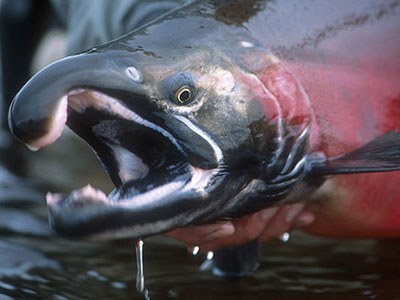
The Land Trust's 2016 January Nature Night is all about Salmon in the Deschutes. Want to brush up on your salmon facts before then? Here are 10 facts about salmon that you may not have known:
1. Chinook are the largest of the Pacific salmon we see in the Northwest. Their large size allows them to spawn in larger gravel than most other salmon. Pink salmon are the smallest.
2. Chinook can live up to nine years and can grow to be more than 100 lbs! These bigger fish are rare, and most mature Chinook are under 50 lbs.
3. On average, salmon live 4-5 years, but can live up to 7 years.
4. There are 8 species of Pacific salmon: Chinook, Coho, Chum, Sockeye, Pink, Steelhead trout, Masu and Amago salmon (two Asian species).
5. Salmon species have adapted to use virtually every part of every stream in the Northwest. For example, Pink salmon tend to prefer the lower reaches of bigger rivers like the Lower Columbia River. Chinook salmon will use the main stem of a river like the Deschutes and its larger tributaries like Whychus Creek. Coho prefer smaller tributaries.
6. Salmon change color to attract a spawning mate, and many male salmon develop a hooked jaw during spawning called a kype. Those salmon with the larger kype have been said to be dominant over those with a smaller kype.
7. Female salmon can have between 1500 and 10,000 eggs and only 0-10 of these eggs will survive to be adults. On average, two adults per spawning pair are produced.
8. Chinook rear in freshwater from 3 months to a year. Spring Chinook and fish in northern areas tend to stay in streams for a year.
9. Salmon are considered a keystone species--a species on which other species in nature depend. Not only do salmon provide nutrients for streams and rivers because they die after they spawn, they are also a key part of the diet of other land-dwelling wildlife. Studies have shown that salmon play an important role in returning nutrients to forests by other animals dragging salmon carcasses from the stream and into the forest to eat. When keystone species are removed from their habitats, many parts of the natural system begin to change. Other examples of keystone species include beavers and wolves.
10. Chinook salmon make up 80% of the summer diet of killer whales in the Pacific Northwest, telling us that salmon habitat restoration in Central Oregon has implications as far away as the Pacific Ocean. Our waters are all connected!
Land Trust properties are an important part of salmon recovery in Oregon. The waters of Whychus Creek, Lake Creek, Crooked River, McKay Creek, and others play a vital role in the spawning and rearing of ocean-going fishes. Restoration of fish habitat along these waterways has been our focus, and continues to be through the Campaign for Whychus Creek.
Sources:
USGS Western Fisheries Research Center: http://wfrc.usgs.gov/outreach/salmon.html
Port Gamble S'Klallam Tribe: http://www.pgst.nsn.us/content/pdfs/SalmonFacts.pdf


